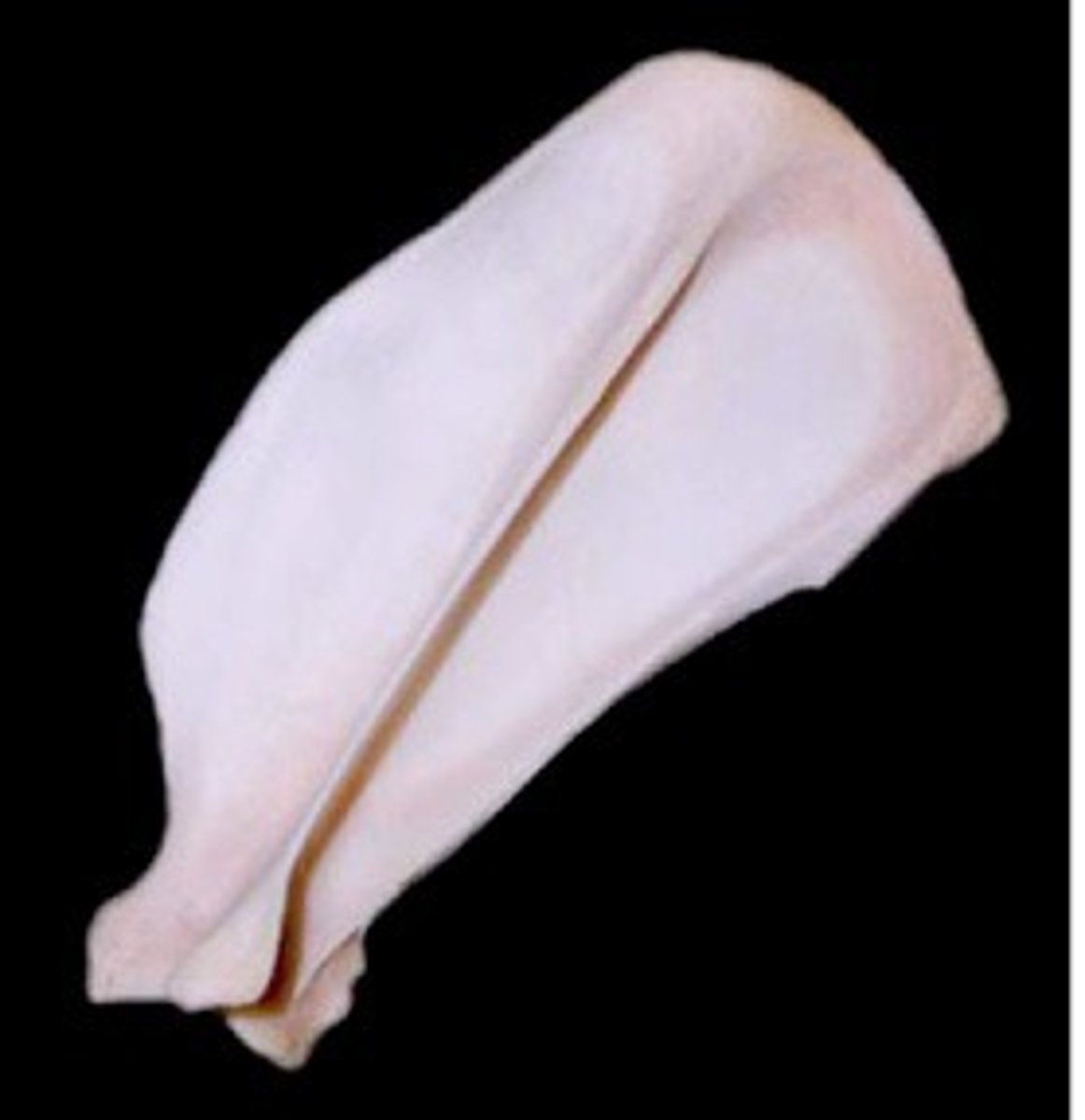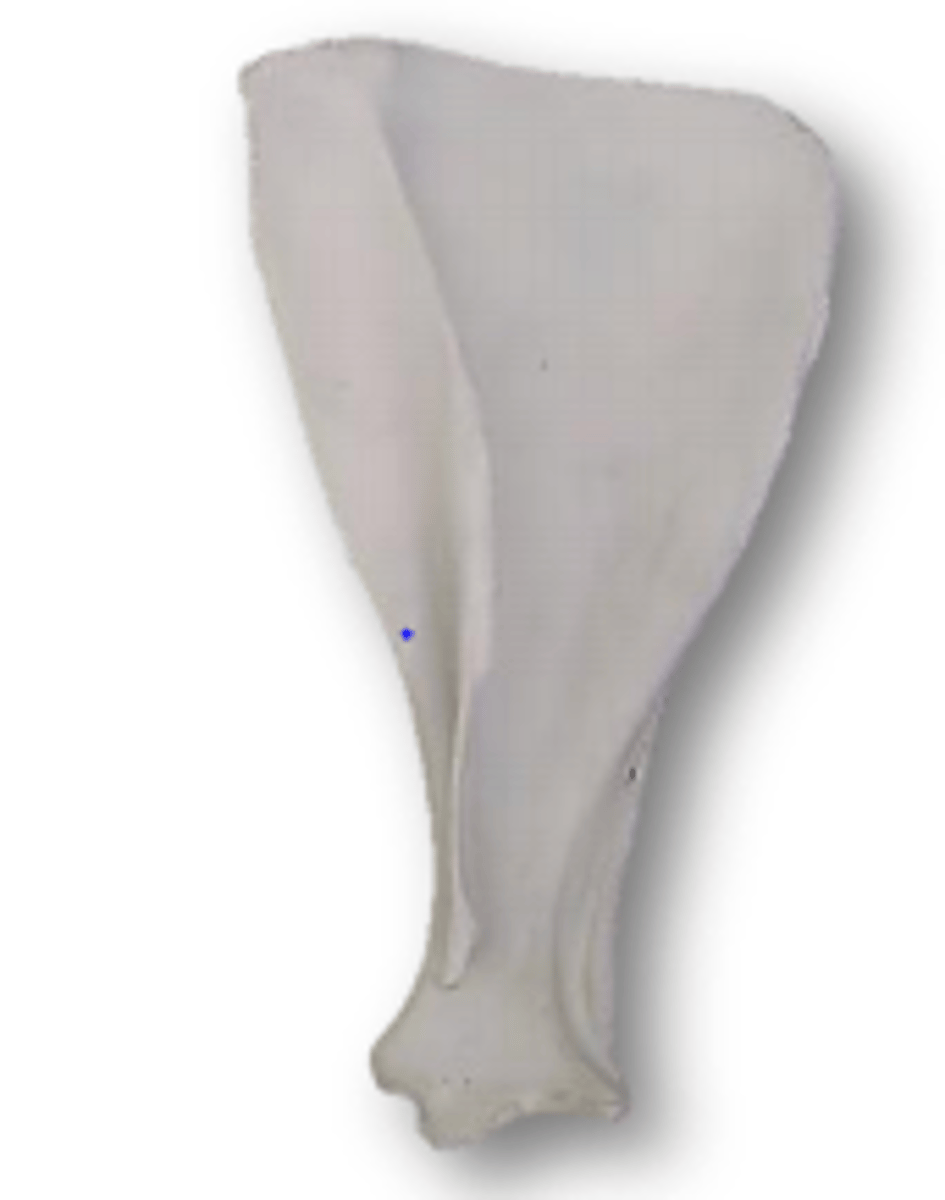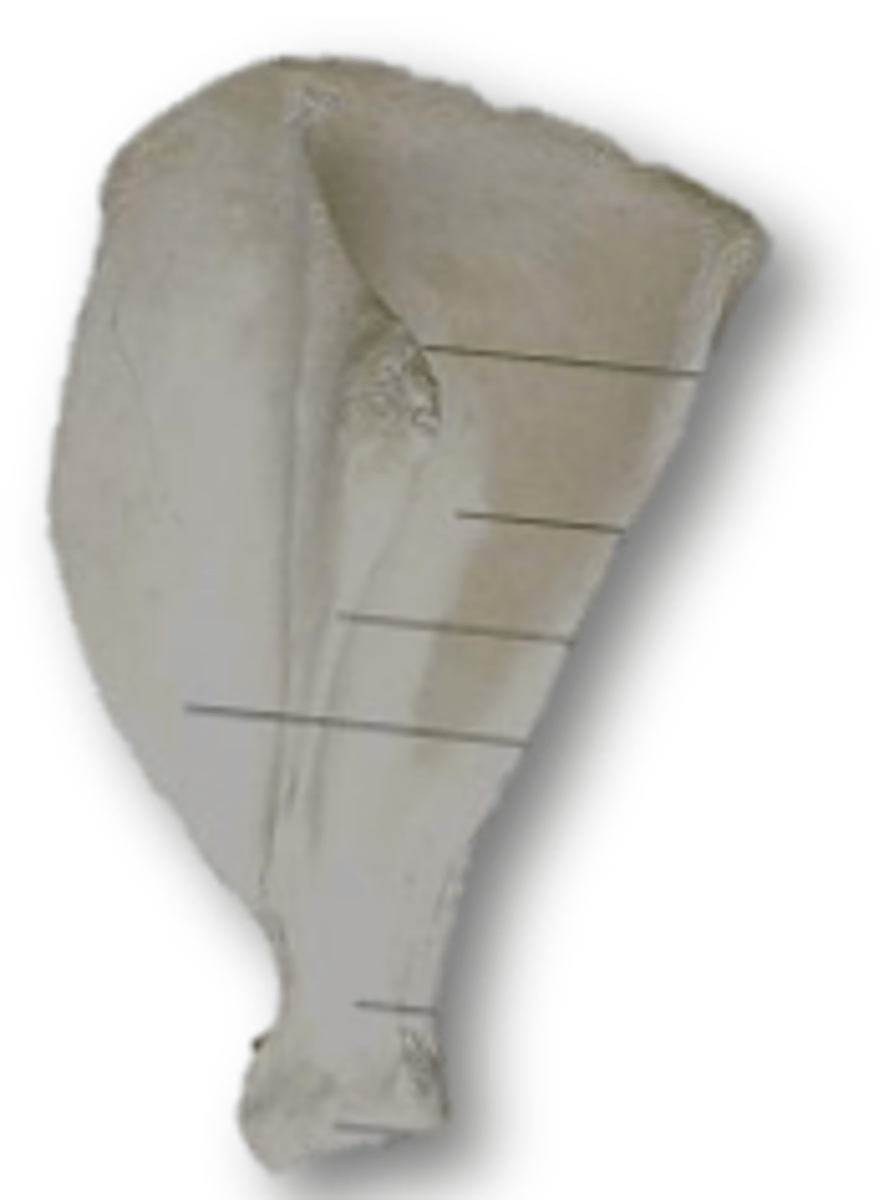Comparative Anatomy
1/27
There's no tags or description
Looks like no tags are added yet.
Name | Mastery | Learn | Test | Matching | Spaced |
|---|
No study sessions yet.
28 Terms
What are the defining characteristics of a dog's scapula?
- Acromion process
- no tuber spine
- supraglenoid tubercle is part of the glenoid cavity

What are the defining characteristics of a horse's scapula?
- narrow supraspinous fossa
- no acromion process
- prominent tuber spine
- supraglenoid tubercle is separate from the glenoid cavity
- glenoid notch is present

What are the defining characteristics of a cow's scapula?
- broad dorsal border with extensive cartilage + larger infraspinous fossa than horses
- acromion process is there but doesn't extend into the glenoid cavity
- indistinct glenoid notch

What are the defining characteristics of a pig's scapula?
- rounded cranial border
- very prominent tuber spine
- poorly defined acromion

What are the defining characteristics of a Horse's humerus?
- greater tubercle divided into two parts - cranial and caudal level with humeral head
- double inter tubercular groove
- lesser tubercle much smaller
- no supratrochlear foramen
- very prominent deltoid tuberosity
What are the defining characteristics of a dog's humerus?
-single greater tubercle
- supratrochlear foramen
What are the defining characteristics of a cow's humerus?
- very enlarged greater tubercle
- greater tubercle spilt into two parts- cranial and caudal but much higher level than humeral head, pointed shape
- single intertubercular groove
- circular area on lateral aspect of greater tubercle for insertion of infraspinatus muscle (flattened 'thumb print')
- deltoid tuberosity is small relative to horses
- no supratrochlear foramen
What are the defining characteristics of a pig's humerus?
(similar to cow)
- greater tubercle has two parts (cranial and caudal), also higher than humeral head, rounded shape that almost encloses the intertubercular groove
- single intertuberuclar groove
- no supratrochlear foramen
- no flattened 'thumb print'
What are the defining characteristics of dog's and cat's radius and ulna?
- 2 separate complete bones
- rotation possible
What are the defining characteristics of a horse's radius and ulna?
- ulnar greatly reduced
-ulnar fused to radius, no body to ulna
- no annular ligament
- distal ulnar is present but fused- has lateral styloid process
- radius has medial styloid process
- no rotation possible
What are the defining characteristics of a ruminant's radius and ulna?
- 2 complete bones
-fuse as animal ages
- no rotation
What are the defining characteristics of pig's radius and ulna?
- 2 complete, separate bones
- ulnar same diameter as radius
- no interosseous space
- no rotation
What are the defining characteristics of the carpus of a dog or cat?
- redial and intermediate bones are fused
What are the defining characteristics of the carpus of a horse?
- first carpal bone is usually absent
What are the defining characteristics of the carpus of a pig?
- all bones are present
What are the defining characteristics of the carpus of a ruminant?
- proximal row all present
- distal row: 1st absent, 2nd and 3rd are fused
What structures run through the carpal canal of a Dog and Cat?
- only DDFT
What structures run through the carpal canal of a horse?
- DDFT and SDFT
What structures run through the carpal canal of a ruminant or pig?
- DDFT and one of the 2 branches of the SDFT
What are the defining features of the manus in the dog?
- digitigrade
- weight bearing on the digits 2-5
- 1st digit is vestigial (dew claw)
What are the defining features of the manus in the horse?
- unguligrade
- perissodactyla
- weight bears on distal phalanx
- only 3rd metacarpal and digit present
- metacarpals 2 and 4 are vestigial (splint bones)
What are the defining features of the manus in a ruminant?
-unguligrade
- Artiodactyla
- 3rd and 4th digits present
- weight bears on distal phalanx
What are the defining features of the manus in the pig?
- posses digits 2-5 but weight bear on 3 and 4
Describe the metacarpal bones of ruminants
MC 1+2 are absent
MC 3+4:
- separate in the foetus but fuse while they're still in the uterus.
- two medullary cavities
- axial bony septum
- proximal end, one common articular surface
- distal end has 2 articular surfaces
- 4 centres for ossification
MC 5: vestigial spur
What are the features of the metacarpal joints in ruminants?
- 2 MCP joint
- 2 pairs of proximal sesamoids
- no dorsal sesamoids
- 2 distal sesamoid bones (one at each DIP joint)
- 2 PIP joints
What structures support the MCP joint in ruminants?
- Medial and lateral collateral ligaments: axial collateral ligaments fused proximally into v-shaped structure
- Inter-sesamoidean ligaments: proximal cartilaginous reinforcements known as suta
- Interdigital sesamoidean ligament: only found in cows- keeps 2 digits in place
- Distal sesamoidean ligaments: short, cruciate
- Inter digital phalangeal sesamoidean ligament: axial aspect sesamoid- opposite PP, helps hold digits together
How does the suspensory ligament in ruminants differ to horse's?
- divides into 2 branches
- wraps around DDFT, fuses with SDFT- acts like check ligament
IS lameness more common in the forelimb or hindlimb?
Forelimb because it's more weight bearing.
Prone to traumatic leisions and osteochondrosis (inflammation of cartilage around articular surfaces)